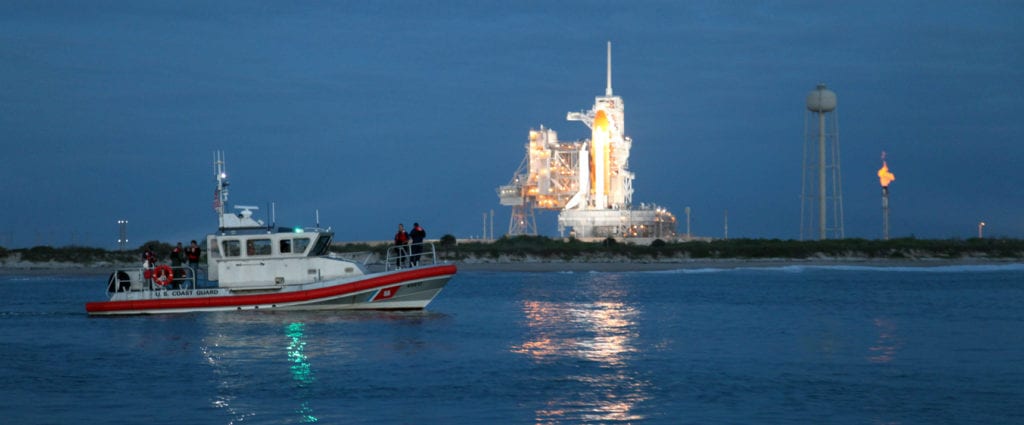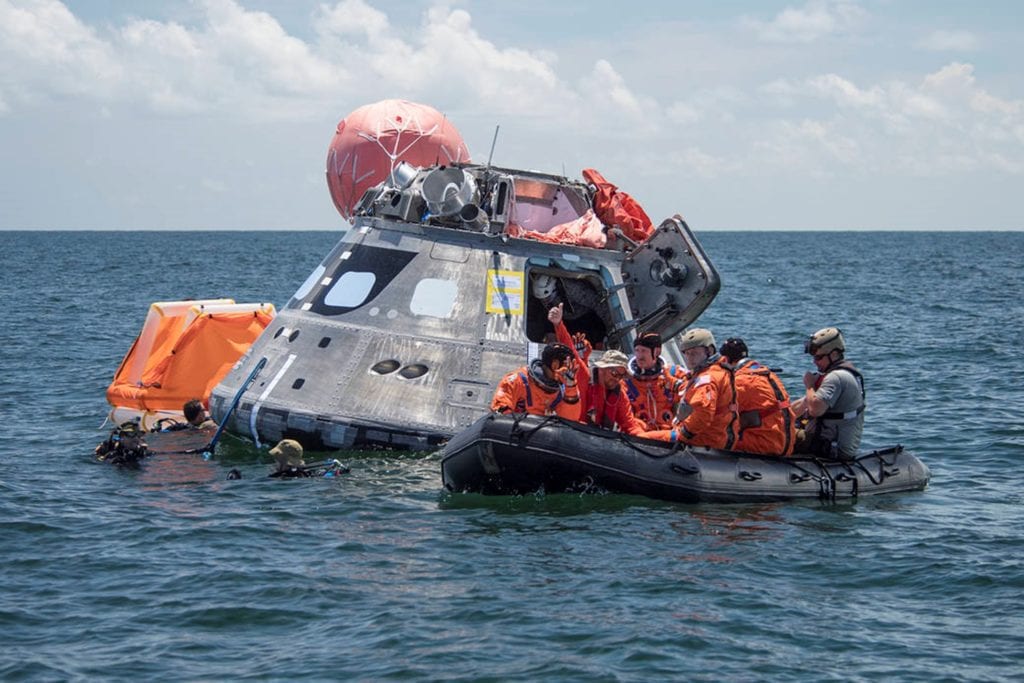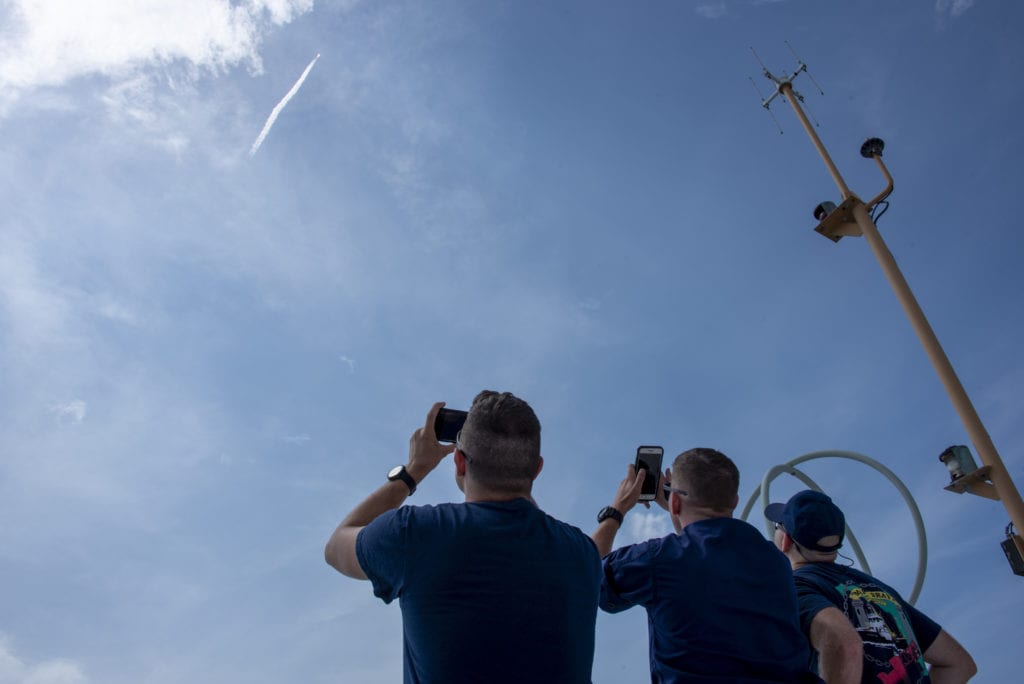
The world was transfixed with the images of the NASA Perseverance rover landing on Mars in February. Like all space missions, it involved a myriad of partners and collaborators. Even the U.S. Coast Guard plays an important but little-known role in launch operations. In fact, the service is involved in ensuring maritime safety and security for almost every U.S. space launch.
NASA, Department of Defense and commercial space launch sites are located next to the ocean. In addition to the Kennedy Space Center (KSC) at Cape Canaveral in Florida, NASA and the Air Force also use Vandenberg Air Force Base near Lompoc, California, on the West Coast. NASA also conducts launches from its Wallops Island facility near Chincoteague, Virginia, and SpaceX has developed a commercial launch facility at Boca Chica near Brownsville, Texas, on the Gulf of Mexico. The Navy has the ability to launch targets from the Pacific Missile Range Facility on the island of Kauai, but these are not orbital missions. Other space ports are planned.
“We’ve been a mission supporter since 1955,” said Cmdr. Jill Lamb, chief of response for Sector Jacksonville, Florida.
When the space shuttle program shut down, major missions departing from the U.S. also wound down. That’s changed, however. The volume of space missions is growing as companies provide more opportunities to launch payloads, and space tourism is becoming a thing. Business is booming.
“We use a local risk assessment tool for each launch,” said Lamb. “It’s scalable, so we can look at all the factors and adjust our force laydown. It might vary, depending on if were dealing with a satellite launch or an astronaut launch.”
The Coast Guard has a memorandum of agreement with the Space Force’s 45th Space Wing. During major evolutions at the space center, the 45th, working with NASA and the commercial providers, will publish the limited access safety zone and establish a command center where the Coast Guard will participate. On launch day, the Coast Guard will monitor and patrol that zone.
Lamb said the captain of the port (COTP) promulgates a notice to mariners and local notice to mariners to set forth those limited access safety areas. In the case of the KSC launches, the COTP is the sector commander at Jacksonville, assisted by the commanding officer of Station Port Canaveral. On the day of the launch, the warnings are broadcast on marine radio channels. The restricted areas are created to keep unwary boaters or gawkers from being under an area where debris or hazardous materials might fall during a launch.
According to Chief Warrant Officer John Chandler, Station Port Canaveral’s commanding officer, the highest risk during a launch is typically within the first minute or minute and a half, depending on launch vehicle, configuration, and other factors. In some cases, flight abort tests intentionally come down shortly after launch.

“As the local unit, we always maintain a standby SAR [search and rescue] posture,” Chandler said. “During those launches that are deemed high risk, or when we receive a request from the 45th for surveillance assets, our vessels would patrol within the launch danger area, ensuring vessel masters are aware of the hazardous areas and CG enforceable limited access areas [LAAs]. Our job with the USSF day of launch is to provide CG authority in the event a boater is causing the overall risk analysis to increase, which can affect proceeding to launch, hold or scrub.”
Usually, the mere act of informing the boaters to clear out is enough.
“No one really wants to place their vessels in any unwarranted danger. But, if our crews encounter vessels within the LAAs, we are authorized by the COTP to provide notification of violation and initiate additional enforcement documentation if necessary. Thus, for those masters who are less than cooperative, we make sure they understand that these areas are under Coast Guard authority and civil and criminal penalties can be applied.”
While space launches were traditionally a NASA show, today’s launch activities are increasing commercial operations.
“We interact with Canaveral Port Authority, Brevard County Sheriff’s Office, and Florida Fish and Wildlife,” Chandler said. “Our launch partnerships include Space Force, Air Force, NASA, FAA, as well as the launch providers themselves, such as SpaceX, United Launch Alliance, Blue Origin, Boeing and Orbital ATK.”
The sector commander also wears the officer in charge of marine inspection hat and, as such, is involved with inspecting and approving vessels such as the autonomous barges used to recover the booster sections and return them to port.
“They use some highly specialized maritime vessels, and we go aboard to ensure compliance with regulations and safety requirements,” Lamb said. “It’s becoming more challenging to learn these new vessels. They don’t fit squarely into the typical ship categories we’re used to, and each of these commercial operators have their own types of vessels. And as the technology advances and their experience grows, the operators are constantly adjusting their procedures and modifying their vessels, which means we need to conduct frequent inspections to deal with the changes.”
Historic Role
From its Cape Canaveral location just south of the Kennedy Space Center and the launch complexes operated by NASA and the U.S. Air Force, Port Canaveral has played a long and historic role in the development and growth of the space industry on Florida’s Space Coast.
Large assemblies and materials such as bulk fuels can arrive by sea at Port Canaveral. The port is an extremely busy cruise ship homeport, and also hosts Navy submarines when they call at the Navy Ordnance Test Unit.
According to Port Canaveral CEO Capt. John Murray, “Public interest in commercial space operations such as crew capsule splashdowns and recovery of space-related assets has grown as the industry’s operational cadence has increased.”
The port worked with the Coast Guard and local and state law enforcement agencies to create the security model for recovery missions off the coast of Florida.

Traditionally, Coast Guard safety zones may not extend beyond U.S. waters. In December 2020, Congress included a provision to expand the safety zone authority from 12 miles up to 200 miles offshore in the National Defense Authorization Act. This gives the Coast Guard the ability and authority to set and enforce restricted vessel navigation zones to protect the safety and security of offshore and at sea space recovery operations.
Port Canaveral also worked with its state law enforcement partners at the Florida Fish and Wildlife Conservation Commission (FWC) and commercial and military space partners to craft proposed legislation that would allow for FWC personnel to come alongside the U.S. Coast Guard in enforcing restricted vessel traffic and access to near-shore recovery operations in Florida’s coastal waters.
A new space port is being established in the Gulf of Mexico. The SpaceX South Texas launch site, also known as the Boca Chica launch site, is a private rocket production facility, test site and spaceport constructed by SpaceX, located approximately 32 kilometers east of Brownsville, Texas, on the U.S. Gulf Coast. Those launches will be supported by Sector Corpus Christi and Station South Padre Island.
The Coast Guard has the additional job of recovering rocket boosters and returning them to port. Due to the trajectories, the boosters are not jettisoned close to the launch sites — in the case of Canaveral launches, they are recovered off North Carolina. This work started in the era of the space shuttle but continues, although now some booster sections are landing on autonomous barges so they can return to port and be reloaded for a subsequent flight.
Now that U.S. capsules are once again returning to Earth, the Coast Guard has worked closely with NASA and SpaceX to plan the recovery of the SpaceX Dragon crew in August 2020. The Coast Guard established a safety zone and warned boaters to stay out of the zone before splashdown. Mariners were alerted to pending hazardous operations within a specified boundary by a broadcast notice to mariners. The zone went into effect three hours before the capsule splashed into the Gulf.
“When a when capsule detaches from the ISS, it’s coming home pretty quick,” Lamb said. “We need to be in the right place at the right time.”
When the two NASA astronauts landed in the water near Pensacola, Florida, boaters basically ignored the safety zone. The Coast Guard was not involved in recovering the crew or the capsule but was helping to keep the area clear. Boaters crowded around the spacecraft while recovery crews tried to get to the Dragon capsule and get the crew safely onto the recovery boat.
The Coast Guard said later that “numerous boaters ignored the Coast Guard crews’ warnings and decided to encroach the area, putting themselves and those involved in the operation in potential danger,” according to a statement.
More recently, an unmanned SpaceX CRS-21 Cargo Dragon capsule came down in the Gulf of Mexico west of Tampa Bay in January of this year. The Coast Guard established the safety zone and warned boaters to stay out before splashdown. The zone went into effect three hours before the capsule splashed into the Gulf exactly on time, and this time there was no interference.
While launches are becoming more routine, Lamb said they’re still spectacular to observe. “It’s a pretty incredible view.”
- A Day to Remember - September 11, 2023
- Indo-Pacific Maritime Security Exchange will examine emerging capabilities and capacity - July 12, 2023
- Cold Waters Spark Warm Relationship - April 20, 2023




